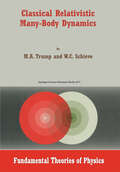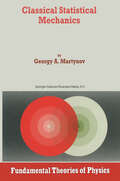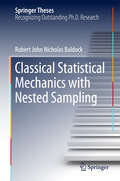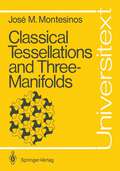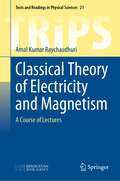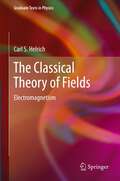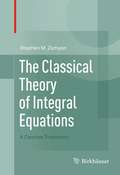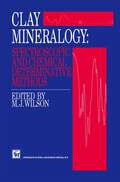- Table View
- List View
Classical Relativistic Many-Body Dynamics (Fundamental Theories of Physics #103)
by M.A. Trump W.C. Schievein this work, we must therefore assume several abstract concepts that hardly need defending at this point in the history of mechanics. Most notably, these include the concept of the point particle and the concept of the inertial observer. The study of the relativistic particle system is undertaken here by means of a particular classical theory, which also exists on the quantum level, and which is especially suited to the many-body system in flat spacetime. In its fundamental postulates, the theory may be consid ered to be primarily the work of E.C.G. Stiickelberg in the 1940's, and of L.P. Horwitz and C. Piron in the 1970's, who may be said to have provided the generalization of Stiickelberg's theory to the many-body system. The references for these works may be found in Chapter 1. The theory itself may be legitimately called off-shell Hamiltonian dynamics, parameterized relativistic mechanics, or even classical event dynamics. The most important feature of the theory is probably the use of an invariant world time parameter, usually denoted T, which provides an evolution time for the system in such as way as to allow manifest co variance within a Hamiltonian formalism. In general, this parameter is neither a Lorentz-frame time, nor the proper time of the particles in the system.
Classical Statistical Mechanics (Fundamental Theories of Physics #89)
by G.A. MartynovStatistical mechanics deals with systems in which chaos and randomness reign supreme. The current theory is therefore firmly based on the equations of classical mechanics and the postulates of probability theory. This volume seeks to present a unified account of classical mechanical statistics, rather than a collection of unconnected reviews on recent results. To help achieve this, one element is emphasised which integrates various parts of the prevailing theory into a coherent whole. This is the hierarchy of the BBGKY equations, which enables a relationship to be established between the Gibbs theory, the liquid theory, and the theory of nonequilibrium phenomena. As the main focus is on the complex theoretical subject matter, attention to applications is kept to a minimum. The book is divided into three parts. The first part describes the fundamentals of the theory, embracing chaos in dynamic systems and distribution functions of dynamic systems. Thermodynamic equilibrium, dealing with Gibbs statistical mechanics and the statistical mechanics of liquids, forms the second part. Lastly, the third part concentrates on kinetics, and the theory of nonequilibrium gases and liquids in particular. Audience: This book will be of interest to graduate students and researchers whose work involves thermophysics, theory of surface phenomena, theory of chemical reactions, physical chemistry and biophysics.
Classical Statistical Mechanics with Nested Sampling (Springer Theses)
by Robert John BaldockThis thesis develops a nested sampling algorithm into a black box tool for directly calculating the partition function, and thus the complete phase diagram of a material, from the interatomic potential energy function. It represents a significant step forward in our ability to accurately describe the finite temperature properties of materials. In principle, the macroscopic phases of matter are related to the microscopic interactions of atoms by statistical mechanics and the partition function. In practice, direct calculation of the partition function has proved infeasible for realistic models of atomic interactions, even with modern atomistic simulation methods. The thesis also shows how the output of nested sampling calculations can be processed to calculate the complete PVT (pressure–volume–temperature) equation of state for a material, and applies the nested sampling algorithm to calculate the pressure–temperature phase diagrams of aluminium and a model binary alloy.
Classical Tessellations and Three-Manifolds (Universitext)
by José María Montesinos-AmilibiaThis unusual book, richly illustrated with 29 colour illustrations and about 200 line drawings, explores the relationship between classical tessellations and three-manifolds. In his original and entertaining style, the author provides graduate students with a source of geometrical insight into low-dimensional topology. Researchers in this field will find here an account of a theory that is on the one hand known to them but here is "clothed in a different garb" and can be used as a source for seminars on low-dimensional topology, or for preparing independent study projects for students, or again as the basis of a reading course.
Classical Theory of Electricity and Magnetism: A Course of Lectures (Texts and Readings in Physical Sciences #21)
by Amal Kumar RaychaudhuriThis book examines the topics of magnetohydrodynamics and plasma oscillations, in addition to the standard topics discussed to cover courses in electromagnestism, electrodynamics, and fundamentals of physics, to name a few. This textbook on electricity and magnetism is primarily targeted at graduate students of physics. The undergraduate students of physics also find the treatment of the subject useful. The treatment of the special theory of relativity clearly emphasises the Lorentz covariance of Maxwell's equations. The rather abstruse topic of radiation reaction is covered at an elementary level, and the Wheeler–Feynman absorber theory has been dwelt upon briefly in the book.
The Classical Theory of Fields: Electromagnetism (Graduate Texts in Physics)
by Carl S. HelrichThe study of classical electromagnetic fields is an adventure. The theory is complete mathematically and we are able to present it as an example of classical Newtonian experimental and mathematical philosophy. There is a set of foundational experiments, on which most of the theory is constructed. And then there is the bold theoretical proposal of a field-field interaction from James Clerk Maxwell. This textbook presents the theory of classical fields as a mathematical structure based solidly on laboratory experiments. Here the student is introduced to the beauty of classical field theory as a gem of theoretical physics. To keep the discussion fluid, the history is placed in a beginning chapter and some of the mathematical proofs in the appendices. Chapters on Green’s Functions and Laplace’s Equation and a discussion of Faraday’s Experiment further deepen the understanding. The chapter on Einstein’s relativity is an integral necessity to the text. Finally, chapters on particle motion and waves in a dispersive medium complete the picture. High quality diagrams and detailed end-of-chapter questions enhance the learning experience.
The Classical Theory of Integral Equations: A Concise Treatment
by Stephen M. ZemyanThe Classical Theory of Integral Equations is a thorough, concise, and rigorous treatment of the essential aspects of the theory of integral equations. The book provides the background and insight necessary to facilitate a complete understanding of the fundamental results in the field. With a firm foundation for the theory in their grasp, students will be well prepared and motivated for further study. Included in the presentation are: A section entitled Tools of the Trade at the beginning of each chapter, providing necessary background information for comprehension of the results presented in that chapter;Thorough discussions of the analytical methods used to solve many types of integral equations;An introduction to the numerical methods that are commonly used to produce approximate solutions to integral equations;Over 80 illustrative examples that are explained in meticulous detail; Nearly 300 exercises specifically constructed to enhance the understanding of both routine and challenging concepts; Guides to Computation to assist the student with particularly complicated algorithmic procedures. This unique textbook offers a comprehensive and balanced treatment of material needed for a general understanding of the theory of integral equations by using only the mathematical background that a typical undergraduate senior should have. The self-contained book will serve as a valuable resource for advanced undergraduate and beginning graduate-level students as well as for independent study. Scientists and engineers who are working in the field will also find this text to be user friendly and informative.
Classical Trajectory Perspective of Atomic Ionization in Strong Laser Fields: Semiclassical Modeling (SpringerBriefs in Physics)
by Jie LiuThe ionization of atoms and molecules in strong laser fields is an active field in modern physics and has versatile applications in such as attosecond physics, X-ray generation, inertial confined fusion (ICF), medical science and so on. Classical Trajectory Perspective of Atomic Ionization in Strong Laser Fields covers the basic concepts in this field and discusses many interesting topics using the semiclassical model of classical trajectory ensemble simulation, which is one of the most successful ionization models and has the advantages of a clear picture, feasible computing and accounting for many exquisite experiments quantitatively. The book also presents many applications of the model in such topics as the single ionization, double ionization, neutral atom acceleration and other timely issues in strong field physics, and delivers useful messages to readers with presenting the classical trajectory perspective on the strong field atomic ionization. The book is intended for graduate students and researchers in the field of laser physics, atom molecule physics and theoretical physics. Dr. Jie Liu is a professor of Institute of Applied Physics and Computational Mathematics, China and Peking University.
Classification Methods for Remotely Sensed Data
by Paul M. Mather Taskin Kavzoglu Brandt TsoThe third edition of the bestselling Classification Methods for Remotely Sensed Data covers current state-of-the-art machine learning algorithms and developments in the analysis of remotely sensed data. This book is thoroughly updated to meet the needs of readers today and provides six new chapters on deep learning, feature extraction and selection, multisource image fusion, hyperparameter optimization, accuracy assessment with model explainability, and object-based image analysis, which is relatively a new paradigm in image processing and classification. It presents new AI-based analysis tools and metrics together with ongoing debates on accuracy assessment strategies and XAI methods.New in this edition: Provides comprehensive background on the theory of deep learning and its application to remote sensing data. Includes a chapter on hyperparameter optimization techniques to guarantee the highest performance in classification applications. Outlines the latest strategies and accuracy measures in accuracy assessment and summarizes accuracy metrics and assessment strategies. Discusses the methods used for explaining inherent structures and weighing the features of ML and AI algorithms that are critical for explaining the robustness of the models. This book is intended for industry professionals, researchers, academics, and graduate students who want a thorough and up-to-date guide to the many and varied techniques of image classification applied in the fields of geography, geospatial and earth sciences, electronic and computer science, environmental engineering, etc.
Classification Methods for Remotely Sensed Data
by Paul M. Mather Taskin Kavzoglu Brandt TsoThe third edition of the bestselling Classification Methods for Remotely Sensed Data covers current state-of-the-art machine learning algorithms and developments in the analysis of remotely sensed data. This book is thoroughly updated to meet the needs of readers today and provides six new chapters on deep learning, feature extraction and selection, multisource image fusion, hyperparameter optimization, accuracy assessment with model explainability, and object-based image analysis, which is relatively a new paradigm in image processing and classification. It presents new AI-based analysis tools and metrics together with ongoing debates on accuracy assessment strategies and XAI methods.New in this edition: Provides comprehensive background on the theory of deep learning and its application to remote sensing data. Includes a chapter on hyperparameter optimization techniques to guarantee the highest performance in classification applications. Outlines the latest strategies and accuracy measures in accuracy assessment and summarizes accuracy metrics and assessment strategies. Discusses the methods used for explaining inherent structures and weighing the features of ML and AI algorithms that are critical for explaining the robustness of the models. This book is intended for industry professionals, researchers, academics, and graduate students who want a thorough and up-to-date guide to the many and varied techniques of image classification applied in the fields of geography, geospatial and earth sciences, electronic and computer science, environmental engineering, etc.
Classification of Nuclear C*-Algebras. Entropy in Operator Algebras (Encyclopaedia of Mathematical Sciences #126)
by M. Rordam E. Stormerto the Encyclopaedia Subseries on Operator Algebras and Non-Commutative Geometry The theory of von Neumann algebras was initiated in a series of papers by Murray and von Neumann in the 1930's and 1940's. A von Neumann algebra is a self-adjoint unital subalgebra M of the algebra of bounded operators of a Hilbert space which is closed in the weak operator topology. According to von Neumann's bicommutant theorem, M is closed in the weak operator topology if and only if it is equal to the commutant of its commutant. Afactor is a von Neumann algebra with trivial centre and the work of Murray and von Neumann contained a reduction of all von Neumann algebras to factors and a classification of factors into types I, II and III. C* -algebras are self-adjoint operator algebras on Hilbert space which are closed in the norm topology. Their study was begun in the work of Gelfand and Naimark who showed that such algebras can be characterized abstractly as involutive Banach algebras, satisfying an algebraic relation connecting the norm and the involution. They also obtained the fundamental result that a commutative unital C* -algebra is isomorphic to the algebra of complex valued continuous functions on a compact space - its spectrum. Since then the subject of operator algebras has evolved into a huge mathematical endeavour interacting with almost every branch of mathematics and several areas of theoretical physics.
Clastic Hydrocarbon Reservoir Sedimentology (Advances in Oil and Gas Exploration & Production)
by Xinghe Yu Shengli Li Shunli LiThis book presents a comprehensive assessment of clastic sedimentology and its application to reservoir geology. It covers the theoretical foundations of the topic and its use for scientists as well as professionals in the field. Further, it addresses all aspects of reservoir sedimentology, clastic sequence stratigraphy, sedimentation, reservoir diagenesis and heterogeneity, as well as depositional systems (alluvial, fluvial, lacustrine, delta, sandy coast, neritic, deep-water) in detail.The research team responsible for this book has been investigating clastic sedimentology for more than three decades and consists of highly published and cited authors. The Chinese edition of this book has been a great success, and is popular among sedimentologists and petroleum geologists alike.
Claxton: Field Notes from a Small Planet
by Mark Cocker'After Mark Cocker’s glorious book, you will never look at a blackberry bush the same way again.' Philip Hoare, New Statesman In 2001 Mark Cocker moved to Claxton, a small village in Norfolk. In a series of daily writings spanning the course of a year he explores his relationship to the landscape he lives in, to nature and to all the living things around him - the birds, plants, trees, mammals, hoverflies, moths, butterflies, bush crickets, grasshoppers, ants and bumblebees. Passionate, astonishing and inspiring, this book is a celebration of the wonder that lies in our everyday experience.Shortlisted for the Royal Society of Biology Book Award, the Jarrold East Anglian Book Awards, the New Angle Prize and theThwaites Wainwright Prize
Clay Microstructure (Geological Sciences Series)
by Richard Bennett Matthew HulbertPlan of Review This review of clay microstructure is aimed at the diverse group of professionals who share an interest in the properties of fine-grained minerals in sediments. During the last several decades, members of this group have included geologists, soil scientists, soil engineers, engineering geologists, and ceramics scientists. More recently, it has included significant numbers of marine geologists and other engineers. Each of the disciplines has developed special techniques for investigating properties of clay sediments that have proven to be fruitful in answering questions of central interest. Knowledge of clay microstructure-the fabric of a sediment and the physico chemical interactions between its components-is fundamental to all these disciplines (Mitchell 1956; Lambe 1958a; Foster and De 1971). Clay fabric refers to the spatial distribution, orientations, and particle-to-particle relations of the solid particles (generally those less than 3. 9 /Lm in size) of sediment. Physico-chemical interac tions are expressions of the forces between the particles. In this review, we trace the historical development of under standing clay microstructure by discussing key scientific papers published before 1986 on physico-chemical interactions in fine grained sediments and on clay fabric. Since the development follows an intricate path, the current view of clay microstructure is summarized. This summary includes a discussion of the present state of knowledge, the observations made so far, and the facts that are now established.
Clay Mineral Cements in Sandstones (International Association Of Sedimentologists Series #19)
by Richard Worden Sadoon MoradClay minerals are one of the most important groups of minerals that destroy permeability in sandstones. However, they also react with drilling and completion fluids and induce fines migration during hydrocarbon production. They are a very complex family of minerals that are routinely intergrown with each other, contain a wide range of solid solutions and form by a variety of processes under a wide range temperatures and rock and fluid compositions. In this volume, clay minerals in sandstones are reviewed in terms of their mineralogy and general occurrence, their stable and radiogenic isotope geochemistry, XRD quantification, their effects on the petrophysical properties of sandstones and their relationships to sequence stratigraphy and palaeoclimate. The controls on various clay minerals are addressed and a variety of geochemical issues, including the importance of mass flux, links to carbonate mineral diagenesis and linked clay mineral diagenesis in interbedded mudstone-sandstone are explored. A number of case studies are included for kaolin, illite and chlorite cements, and the occurrence of smectite in sandstone is reviewed. Experimental rate data for clay cements in sandstones are reviewed and there are two model-based case studies that address the rates of growth of kaolinite and illite. The readership of this volume will include sedimentologists and petrographers who deal with the occurrence, spatial and temporal distribution patterns and importance of clay mineral cements in sandstones, geochemists involved in unraveling the factors that control clay mineral cement formation in sandstones and petroleum geoscientists involved in predicting clay mineral distribution in sandstones. The book will also be of interest to geologists involved in palaeoclimate studies basin analysis. Latest geochemical data on clays in sandstones Provides important information for geologists involved in basin analysis, sandstone petrology and petroleum geology If you are a member of the International Association of Sedimentologists (IAS), for purchasing details, please see: http://www.iasnet.org/publications/details.asp?code=SP34
Clay Mineralogy: Spectroscopic and Chemical Determinative Methods
by M. J. WilsonA knowledge of clay is important in many spheres of scientific endeav our, particularly in natural sciences such as geology, mineralogy and soil science, but also in more applied areas like environmental and mater ials science. Over the last two decades research into clay mineralogy has been strongly influenced by the development and application of a num ber of spectroscopic techniques which are now able to yield information about clay materials at a level of detail that previously would have seemed inconceivable. This information relates not only to the precise characterization of the individual clay components themselves, but also to the ways in which these components interact with a whole range of absorbate molecules. At present, however, the fruits of this research are to be found principally in a somewhat widely dispersed form in the scientific journals, and it was thus considered to be an appropriate time to bring together a compilation of these spectroscopic techniques in a way which would make them more accessible to the non-specialist. This is the primary aim of this book. The authors of the various chapters first describe the principles and instrumentation of the individual spectro scopic techniques, assuming a minimum of prior knowledge, and then go on to show how these methods have been usefully applied to clay mineralogy in its broadest context.
Clay Minerals: Their Antimicrobial and Antitoxic Applications
by Bhaskar Ghosh Dola ChakrabortyThis book provides a comprehensive description of the application of clay minerals as disinfectants and the ingredients of medicines. While the presently available literature highlights one or two aspects of medicinal clays, a comprehensive text on all their major pharmaceutical applications is lacking. This book endeavors to fill up this lacuna. It further elucidates the properties of clay minerals that facilitate their application in the protection of human health, and how these properties are related to the chemical compositions and internal structures of selected mineral groups, thus revealing to the students, teachers and researchers the underlying relationship of seemingly different disciplines like mineralogy, material science and medical science. The thought-provoking questions added at the end of each chapter will give the readers a better insight of this subject. The tangible definitions and explanations of all the relevant scientific terms provided in this book, both within the text and in a glossary list at the end, are expected to help the beginners to develop a clear-cut understanding regarding different aspects of the subject and clear any confusion resulting from the ambiguous usage of terms in the existing literature.
Clay Sedimentology
by Herve ChamleyClay Sedimentology is a comprehensive textbook divided into six parts: - clay minerals and weathering - clay sedimentation on land - origin and behaviour of clay minerals and associated minerals in transitional environments (estuaries, deltas) and shallow-sea environments - diverse origins of clay in the marine environment - post-sedimentary processes intervening during early and late diagenesis - use of clay stratigraphic data for the reconstruction of past climate, marine circulation, tectonics, and other paleogeographical aspects. A basic idea on most topics dealing with sedimentary clays is presented and controversial data and uncertainties from the frontiers of knowledge are discussed.
Clays
by Alain MeunierHere is a comprehensive and up to-do-date presentation of the origins, and properties of clay minerals at the Earth´s surface. The text reviews the relatively simple laws that govern the chemical or isotopic composition and the crystalline structure of clays, and then discusses their genesis and alteration. Concluding chapters show that clay minerals can form in variety of different environments: meteorites, lavas, subduction zones, among others.
Clays and Health: Properties and Therapeutic Uses
by Michel Rautureau Celso de Figueiredo Gomes Nicole Liewig Mehrnaz Katouzian-SafadiOriginally published in French, this updated and expanded English translation offers a definitive treatment on clays and effects on human health including the long history of clays used as pharmaceutical and therapeutic agents, the origins of clays, their structural properties and modes of action.
Clays in Crustal Environments: Isotope Dating and Tracing
by Norbert Clauer Sambhu ChaudhuriClay minerals form in a wide variety of crustal environments, e.g. in soil profiles, in sediments at the surface and in deeply buried sedimentary deposits, and under regional, contact and hydrothermal metamorphism conditions.The book provides information about the dynamics of isotope systems in clays and helps us to understand the physical and chemical parameters in the transfer of masses within the crustal domain. Written for graduate students taking courses in sedimentary geochemistry, clay mineralogy, and soil mineralogy, the book will also appeal to scientists carrying out research on clay genesis and mass transfer in crustal environments.
Clean: Lessons from Ecolab's Century of Positive Impact
by Paul C. Godfrey Emilio R. TenutaStraightforward strategies for achieving sustainable practices and business success in the modern organization In Clean: Lessons from Ecolab’s Century of Positive Impact, a team of veteran sustainability experts delivers a practical toolkit for creating a forward-looking and sustainability-focused business. From Ecolab’s origins in sustainability 100 years ago to its ambitious 2030 environment and social impact goals, this book lays out a roadmap for business transformation and continued growth – today and for the next 100 years. You’ll explore the principles and methods required to build and lead a sustainable company. You’ll discover how to evolve your focus on sustainability over time, as your organization transforms and grows. You’ll learn to: Build and maintain momentum for sustainability initiatives and cement your firm’s commitment to new practices through iteration and aligning business units around core, shared sustainability goals. Embed new sustainable practices into your organization’s governance and operations DNA Identify and leverage specific sustainability levers that impact a wide variety of key performance indicators Create a set of business processes that enable sustainable future and engage your employees in a higher purposeAn essential playbook for students of sustainability and business, this book is a must-read for the modern manager, executive, or director seeking to solidify their business strategy and future-proof their company. Clean: Lessons from Ecolab’s Century of Positive Impact describes the holistic and comprehensive approach to responsible business that we’ve all been waiting for.
Clean: Lessons from Ecolab's Century of Positive Impact
by Paul C. Godfrey Emilio R. TenutaStraightforward strategies for achieving sustainable practices and business success in the modern organization In Clean: Lessons from Ecolab’s Century of Positive Impact, a team of veteran sustainability experts delivers a practical toolkit for creating a forward-looking and sustainability-focused business. From Ecolab’s origins in sustainability 100 years ago to its ambitious 2030 environment and social impact goals, this book lays out a roadmap for business transformation and continued growth – today and for the next 100 years. You’ll explore the principles and methods required to build and lead a sustainable company. You’ll discover how to evolve your focus on sustainability over time, as your organization transforms and grows. You’ll learn to: Build and maintain momentum for sustainability initiatives and cement your firm’s commitment to new practices through iteration and aligning business units around core, shared sustainability goals. Embed new sustainable practices into your organization’s governance and operations DNA Identify and leverage specific sustainability levers that impact a wide variety of key performance indicators Create a set of business processes that enable sustainable future and engage your employees in a higher purposeAn essential playbook for students of sustainability and business, this book is a must-read for the modern manager, executive, or director seeking to solidify their business strategy and future-proof their company. Clean: Lessons from Ecolab’s Century of Positive Impact describes the holistic and comprehensive approach to responsible business that we’ve all been waiting for.
CLEAN: CO2 Large-Scale Enhanced Gas Recovery in the Altmark Natural Gas Field - GEOTECHNOLOGIEN Science Report No. 19 (Advanced Technologies in Earth Sciences)
by Michael Kühn Ute MünchThe project CLEAN (CO2 Large-Scale Enhanced Gas Recovery in the Altmark Natural Gas Field) provides site specific knowledge for a potential future pilot project. This contributed volume gives an overview and final results of the entire project which is finalized to the end of 2012.
Clean and Sustainable Groundwater in India (Springer Hydrogeology)
by Dipankar Saha Sanjay Marwaha Arunangshu MukherjeeThe book embodies the groundwater issues and challenges in India focusing its sustainable use. It is a compilation of papers presented by the eminent experts from Government departments, academia, research institutes, NGOs and stakeholders who assembled at Kurukshetra on 21st August, 2015 in the event of Bhujal Manthan or “Churning of Groundwater” organized for the first time by Ministry of Water Resources, River Development and Ganga Rejuvenation, the apex Ministry of Water Resource under Government of India.India, as a country, is the highest groundwater extractor in the world. Its service towards attaining the food and clean drinking water security is well documented. This volume addresses the issues of aquifer characterization, groundwater contamination, groundwater resource availability and its sustainable management through community participation in pan-India scenario. This book provides a unique opportunity for its readers to understand groundwater domain in India in its entire gamut. The papers included in the volume were selected carefully from the presentations made in the following four broad topics during the Manthan; (i) groundwater quality, (ii) conjunctive use of surface and groundwater, (iii) management intervention and sustainable use of this resource, and (iv) groundwater problems and application of various techniques. The book contains 20 papers including an introductory chapter by the editors. The content of the book is enriched by contributions from eminent researchers and activists in groundwater domain, like Prof. Tushar Shah, Prof. Himanshu Kulkarni, Dr. D. K. Chadha, Dr. Bharat Sharma and others. The recommendations in the individual papers are of immense significance for keeping the groundwater of the country clean and sustainable. The volume will help the readers to understand the groundwater issues of the country and also assist policy makers to prepare strategies for its better governance and management with environmentally sustainable ways.
